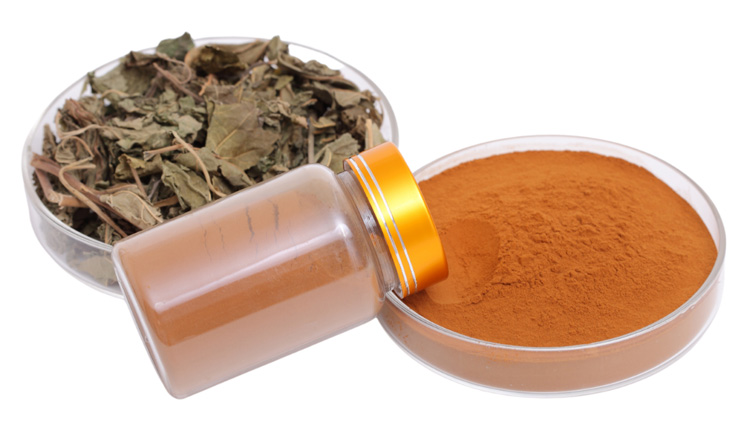Mulberry leaf extract is derived from the first to third new leaves of mulberry tree branches, specifically harvested after the late spring silkworm stage or before the first frost. The leaves are air-dried and ground into powder, and extraction is performed using n-butanol, 90% ethanol, and water, followed by spray drying.
Introduction
This extract is rich in various bioactive substances, including mulberry leaf flavonoids, polyphenols, polysaccharides, deoxynojirimycin (DNJ), and gamma-aminobutyric acid (GABA). These compounds are utilized in the prevention and treatment of cardiovascular diseases, hyperlipidemia, diabetes, and obesity, and for their anti-aging properties. Notably, deoxynojirimycin combines with flavonoids from Pueraria to form a new substance known as Cics (洗胰清糖素), which is effective for reducing blood sugar and blood lipids and possesses anti-inflammatory effects.
Main Functions
The extract offers several therapeutic functions, including:
- Regulating Blood Sugar: The hypoglycemic effect occurs through two main pathways. Firstly, the alkaloid DNJ inhibits the activity of disaccharide-decomposing enzymes, reducing disaccharide absorption in the small intestine and lowering postprandial blood sugar peaks (Kimura, 1995). Secondly, alkaloids such as fagomine and polysaccharides promote insulin secretion from β-cells, enhancing cellular sugar utilization and glycogen synthesis in the liver, ultimately leading to lower blood sugar levels.
- Additional Health Benefits: The extract also disperses wind heat, clears the lungs, moistens dryness, and brightens the liver and eyes, making it indicated for conditions such as wind-heat colds, lung heat cough, headaches, dizziness, and red eyes with blurred vision.
Furthermore, polyhydroxy-deoxynojirimycin isolated from mulberry leaves exhibits strong glycosidase inhibitory effects (Asano et al., 1994). Compounds such as N-Me-DNJ, GAL-DNJ, and fagomine significantly lower blood sugar levels, with GAL-DNJ and fagomine demonstrating the strongest effects.
Preservation Techniques
Conventional processing methods often compromise the active components of mulberry leaves due to heat exposure, such as in the production of mulberry leaf tea or powdered forms. To effectively preserve these components, freeze-drying extraction techniques are recommended. This process involves rapidly freezing the raw materials at ultra-low temperatures and subjecting them to a low-pressure vacuum, allowing the ice to sublimate directly from solid to gas. Compared to other drying methods, freeze-drying minimizes chemical, physical, and enzymatic changes, ensuring the stability of the active components during preservation.
Market Overview
China is rich in mulberry resources, accounting for about half of the 30 species of Moraceae Morus plants worldwide. Mulberry leaves are native to central China and have a cultivation history of approximately four thousand years. The application fields for mulberry leaf extract are diverse, primarily used in medicine, beverages, health care products, cosmetics, and animal products. Specifications typically prioritize mulberry leaf flavonoids greater than or equal to 10%, with DNJ levels specified as DNJ1% and DNJ2%, depending on the product’s requirements.
Suppliers of mulberry leaf extract are mainly concentrated in Sichuan, Shaanxi, Henan, and Guangdong provinces in China. The market demand is seasonal, being lower in summer. By the end of 2013, the market price of mulberry leaves increased by 30%, leading to a slight rise in the prices of mulberry leaf extract. Currently, demand for mulberry leaf extract comes from Asia (Japan, South Korea, and China) and Western Europe (Germany, France, and the United States). However, the international market has stringent quality requirements regarding delivery, color, pesticide residues, heavy metals, and plasticizers.
The primary demand for mulberry leaf extract comes from Japan, the United States, and several European countries. In Japan, health food products made from mulberry leaves are rapidly growing, with dozens of such products available and annual output values reaching several billion yen. These products are popular for their perceived beauty benefits. In the U.S. market, due to their effectiveness in lowering blood sugar and blood pressure, common offerings include mulberry leaf tea and oral liquids, with sales of mulberry leaf health care products steadily increasing. Sales of mulberry leaf tea and juice in the U.S. and European markets now reach millions of dollars annually.
In China, the use of mulberry leaf extract has reached a mature stage, primarily applied in health care products, cosmetics, food and beverages, and livestock and poultry products. The main specifications include mulberry leaf flavonoids greater than or equal to 10% and DNJ levels specified as DNJ1% and DNJ2%. The development of terminal products in the Chinese market is expected to continue growing positively in the future.








